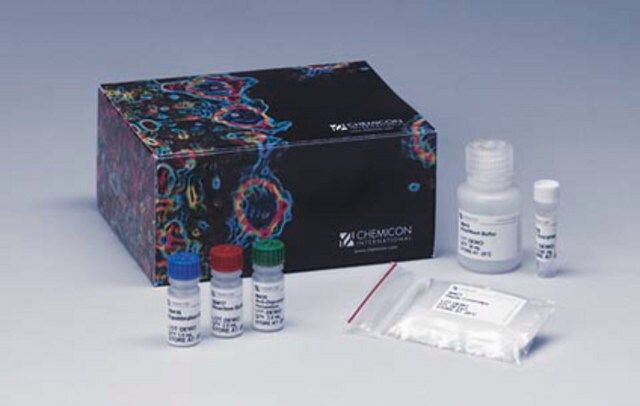您的位置:首页 > 产品中心 > ApopTag Peroxidase In Situ Apoptosis Detection Kit
ApopTag Peroxidase In Situ Apoptosis Detection Kit

| 产品编号: | 4096428 |
| 规格: | The ApopTag Peroxidase In Situ Apoptosis Detection Kit detects apoptotic cells in situ by labeling & detecting DNA strand breaks by the TUNEL method. |
| 包装规格: | 40 ASSAYS |
| 产品类别: | 进口试剂 |
| 品牌: | Sigma-Aldrich |
| 优惠价: | 立即咨询 |
基本信息
| eCl@ss | 32161000 |
| General description【一般描述】 | Apoptosis is a form of cell death that eliminates compromised or superfluous cells. It is controlled by multiple signaling and effector pathways that mediate active responses to external growth, survival, or death factors. Cell cycle checkpoint controls are linked to apoptotic enzyme cascades, and the integrity of these and other links can be genetically compromised in many diseases, such as cancer. There are many books in print and hundreds of recent review articles about all aspects of apoptosis (e.g. 7, 11, 19, 24, 39, 42) and the methods for detecting it (e.g. 10, 32, 36). Of all the aspects of apoptosis, the defining characteristic is a complete change in cellular morphology. As observed by electron microscopy, the cell undergoes shrinkage, chromatin margination, membrane blebbing, nuclear condensation and then segmentation, and division into apoptotic bodies which may be phagocytosed (11, 19, 24). The characteristic apoptotic bodies are short-lived and minute, and can resemble other cellular constituents when viewed by brightfield microscopy. DNA fragmentation in apoptotic cells is followed by cell death and removal from the tissue, usually within several hours (7). A rate of tissue regression as rapid as 25% per day can result from apparent apoptosis in only 2-3% of the cells at any one time (6). Thus, the quantitative measurement of an apoptotic index by morphology alone can be difficult. DNA fragmentation is usually associated with ultrastructural changes in cellular morphology in apoptosis (26, 38). In a number of well-researched model systems, large fragments of 300 kb and 50 kb are first produced by endonucleolytic degradation of higher-order chromatin structural organization. These large DNA fragments are visible on pulsed-field electrophoresis gels (5, 43, 44). In most models, the activation of Ca2+- and Mg2+-dependent endonuclease activity further shortens the fragments by cleaving the DNA at linker sites between nucleosomes (3). The ultimate DNA fragments are multimers of about 180 bp nucleosomal units. These multimers appear as the familiar "DNA ladder" seen on standard agarose electrophoresis gels of DNA extracted from many kinds of apoptotic cells (e.g. 3, 7,13, 35, 44). Another method for examining apoptosis via DNA fragmentation is by the TUNEL assay, (13) which is the basis of ApopTag Apoptosis is distinct from accidental cell death (necrosis). Numerous morphological and biochemical differences that distinguish apoptotic from necrotic cell death are summarized in the following table (adapted with permission from reference 39). The ApopTag |
| Components【组分】 | Equilibration Buffer: 3.0 mL -15°C to -25°C Reaction Buffer 2.0 mL -15°C to -25°C TdT Enzyme 0.64 mL -15°C to -25°C Stop/Wash Buffer 20 mL -15°C to -25°C Anti-Digoxigenin-Peroxidase* 3.0 mL 2°C to 8°C Plastic Coverslips 100 ea. Room Temp. Note: Separate purchase of DAB (Peroxidase Substrate) is required. It is not supplied with this kit. Number of samples per kit: Sufficient materials are provided to stain 40 tissue specimens of approximately 5 mm2 each when used according to instructions. Reaction Buffer will be fully consumed before other reagents when kits are used for slide-mounted specimens. |
| Legal Information【法律信息】 | CHEMICON is a registered trademark of Merck KGaA, Darmstadt, Germany |
产品性质
| Quality Level【质量水平】 | 100 |
| manufacturer/tradename | ApopTag Chemicon® |
| Detection Method | colorimetric |
| shipped in【运输】 | dry ice |
产品说明
| Storage and Stability【储存及稳定性】 | Store the kit at -15°C to -25°C until the first use. After the first use, if the kit will be used within three months, store the TdT Enzyme (90418) at -15°C to -25°C and store the remaining components at 2°C to 8°C. Precautions 1.The following kit components contain potassium cacodylate (dimethylarsinic acid) as a buffer: Equilibration Buffer (90416), Reaction Buffer (90417), and TdT Enzyme (90418). These components are harmful if swallowed; avoid contact with skin and eyes (wear gloves, glasses) and wash areas of contact immediately. 2. Antibody Conjugates (90420) and Blocking Solutions (#10 and #13) contain 0.08% sodium azide as a preservative. 3. TdT Enzyme (90418) contains glycerol and will not freeze at -20°C. For maximum shelf life, do not warm this reagent to room temp. before dispensing. |
| 【免责声明】 | Unless otherwise stated in our catalog or other company documentation accompanying the product(s), our products are intended for research use only and are not to be used for any other purpose, which includes but is not limited to, unauthorized commercial uses, in vitro diagnostic uses, ex vivo or in vivo therapeutic uses or any type of consumption or application to humans or animals. |





